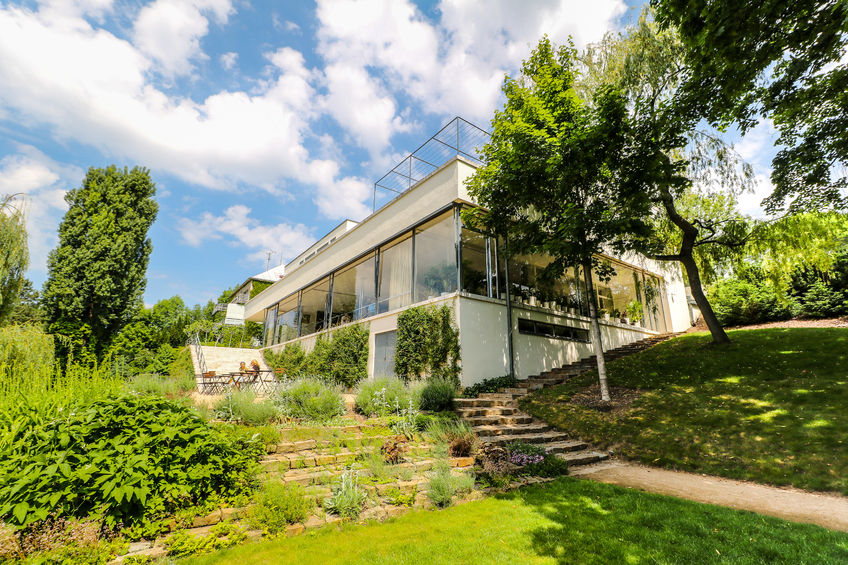Physiotherapy gymnasiums are rarely located within architectural splendour but for a short period in communist Czechoslovakia, a hospital physiotherapy department was located in one of the great buildings of European modernism.
UNESCO World Heritage Listed Villa Tugendhat was built in 1929–1930 for Greta and Fritz Tugendhat to a design by German architect Ludwig Mies van der Rohe. Located in Brno, the vibrant second city of the newly formed Czechoslovakia, the villa is unique in its formal architectural purity, siting in natural surroundings, and its interconnection of rooms, but also in its technical and structural design and use of fine materials. It has become Brno’s icon of modernist housing and occupies a prominent position globally and within the oeuvre of its architect.
Mies built the house on an innovative steel skeleton, removing the need for internal load-bearing walls, and allowing the creation of a vast interior space that is flooded with light through its glass walls. At the flick of a switch, motors whir and the huge windows slide down to floor level, blending the interior with the terrace outside and the tree-filled garden beyond. Mies filled the villa with innovations – hidden as discretely as one would expect by the man who popularised the aphorism “less is more” – from a sophisticated air-conditioning system to a main door controlled by light sensors.

The Glass Room of Villa Tugendhat in Brno, Czech Republic
Alongside specially designed furniture, partitions and shelves of expensive rosewood, zebra-wood and ebony, Mies installed a wall of Moroccan onyx that the shifting light would change from honey-gold to pink with streaks of red, surpassing even his own high expectations of its beauty.
The history of Villa Tugendhat is as fascinating as its cultural significance, and has been portrayed in Simon Mawer’s 2009 Man Booker shortlisted novel The Glass Room and the 2019 movie based on the book, The Affair, directed by Julius Sevcik.
Just eight years after they had moved into the house, Nazi Germany’s occupation of Czechoslovakia forced the Jewish Tugendhats to flee their villa. They sought refuge in Switzerland and then moved to Venezuela, as first the Gestapo and then the Messerschmitt aircraft design bureau occupied Mies’s masterpiece.
When the Soviets drove out the Germans, the Red Army kept horses in the villa’s vast main room. Horse dung and glass from the bomb-shattered windows covered the once milk-white floor, and much of the furniture was used for firewood. In communist Czechoslovakia, the villa served as a dance school and a physiotherapy clinic. Annexed to the Brno Children’s Hospital the 230 square metre glass room was used as a physiotherapy gymnasium.
Throughout his book The Glass Room, author Mawer describes the main room as a ‘palace of light’ and conflates its history as a dance school and physiotherapy gymnasium thought his character Zdenka. Previously a ballet dancer with great aspirations her career was cut short by injury, so she retrained as a physiotherapist. Zdenka explains the effect the room has on her child patients with polio,
Space and light. Their lives are too often dark and closed, shut away indoors because they can’t go out and play, that kind of thing. Coming here is a kind of liberation for them. And for me. You know I dance here sometimes?
In 1970 the City of Brno took over Villa Tugendhat and it was declared a national monument; hosting the signing of the document that divided the country into the Czech and Slovak Republics on 26 August 1992. The building underwent renovation and restoration work in 2010, during which both the structure and the adjoining gardens were restored to their original appearance. It is open for public viewing.
References
Carponen, C. undated. Explore the beguiling real-life set of Julius Sevcik’s wartime drama ‘The Affair’. The Spaces. Accessed online at https://thespaces.com/the-affair-villa-tugendhat/ on 4 September 2023.
Mawer, S. 2009. The Glass Room. Abacus: London.
McCarthy, F. 2012. The Glass Room Restored. The Guardian. Accessed online at https://www.theguardian.com/books/2012/nov/02/glass-room-villa-tugendhat-restored on 4 September 2023.
McLaughlin, D. 2012. Bahaus home reopens after years of dark Czech history. The Irish Times. Accessed online at https://www.irishtimes.com/news/bauhaus-home-reopens-after-years-of-dark-czech-history-1.476588 on 4 September 2023.


Superb find Glenn, really interesting